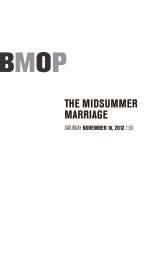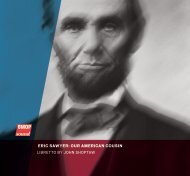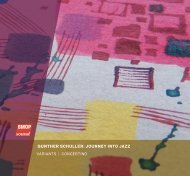Download the album booklet - Boston Modern Orchestra Project
Download the album booklet - Boston Modern Orchestra Project
Download the album booklet - Boston Modern Orchestra Project
You also want an ePaper? Increase the reach of your titles
YUMPU automatically turns print PDFs into web optimized ePapers that Google loves.
dorothy sChwartz, endless forms v, 2009 (Courtesy oF June FItzpatrICk Gallery, portland, maIne)<br />
by Elliott Schwartz<br />
5<br />
Comment<br />
I’ve been fascinated by concertos ever since I was a teenage piano student—dazzled by<br />
<strong>the</strong> tchaikovsky and Grieg piano concertos with <strong>the</strong> virtuoso soloist placed directly in <strong>the</strong><br />
spotlight for maximum one-against-all “heroic” affect. a decade or so later, however, I had<br />
become interested in alternative models: <strong>the</strong> neo-baroque interplay of different weights<br />
and balances, <strong>the</strong> anti-heroic placement of a soloist within complex textures (lowering<br />
<strong>the</strong> spotlight), and possibilities for highlighting <strong>the</strong> <strong>the</strong>atrical/spatial dimensions so<br />
integral to <strong>the</strong> entire concerto enterprise. <strong>the</strong> brandenburg second, bartok’s music for<br />
strings, Percussion and Celesta and Ives’ Unanswered Question are closer to my current<br />
concerto-thinking than <strong>the</strong> liszt or Chopin I loved as a boy.<br />
my six chamber concertos—<strong>the</strong> first two composed in 1976 and <strong>the</strong> last in 2007—can be<br />
heard, <strong>the</strong>refore, as a fusion of solo concerto and concerto grosso. <strong>the</strong>y also reflect my<br />
responses to larger textural issues—<strong>the</strong> simultaneous layering of disparate narratives (akin<br />
to multiple exposures in photography), and <strong>the</strong> interweaving of stylistic cross-references.<br />
on both counts, I’ve been influenced by a number of o<strong>the</strong>r composers—Ives, ravel, and<br />
mahler in particular—who can switch stylistic gears with ease. (I was also lucky enough<br />
to hear major bolcom, rochberg, and Crumb works at <strong>the</strong>ir premiere performances on <strong>the</strong><br />
bowdoin campus.) my own music attempts a similar syn<strong>the</strong>sis of languages, very often<br />
an overlay of non-functional triadic harmony, romantic chromaticism, and <strong>the</strong> angular,<br />
modernist language of <strong>the</strong> twentieth century. <strong>the</strong> resultant fabric might be perceived as<br />
a kind of time warp.










